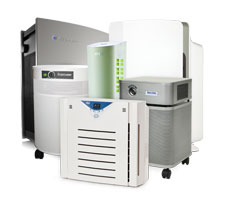 A HEPA air purifier contains a high-efficiency filter that captures 99.97% of particles that pass through the filter, while other air purifier technology can have specific uses each with its own benefits or drawbacks.
A HEPA air purifier contains a high-efficiency filter that captures 99.97% of particles that pass through the filter, while other air purifier technology can have specific uses each with its own benefits or drawbacks.
What is an air purifier?
All air purifiers are designed to help eliminate free flowing particles in the air. Although these particles are not visible to the human eye, they can trigger health problems like allergies, asthma, chemical sensitivity, headaches, and fatigue.
Air purifiers may be filter or filterless, with filterless air purifiers typically requiring less maintenance but also providing less effective filtration. Types of filterless air purifiers include electrostatic air purifiers and ionizers.
Air purifiers that use filters typically work by using a fan to pull air through a filter which is designed to capture airborne particles. The effectiveness of the air purifier depends on both the strength of the fan and the quality of the filter. The most effective filter material is HEPA (High-Efficiency Particulate Air), which removes 99.97% of particles that are 0.3 microns or larger. Complimentary technology used in the filter or unit may target specific airborne particles such as smoke, mold, or odor.
1. How Air Filtration Works on a Microscopic Scale from Blueair North America
Types of Air Purifier
| Type | Description | Effectiveness |
| HEPA (High-Efficiency Particulate Air) | High efficiency HEPA air purifiers effectively capture airborne particles. The percent of particles captured is the highest of any air purification technology available. |
High
|
| Electrostatic Precipitator | Particles are charged and then stick to oppositely charged metal plates within the air purifier. |
Minimal
|
| Ozone Generator | Not safe and effective at removing pollutants. By design, they produce ozone, a lung irritant that can cause adverse health effects. |
Harmful
|
Complementary Technology
Activated Carbon
Effective at removing unpleasant odors, gases, and chemicals in the air. Particles become attracted to, and then trapped within tiny pores in the activated carbon.
Good for: Odor, Gases, Chemicals
UV Light
Kills airborne germs, bacteria and viruses by damaging the bacteria and viruses’ DNA & molecular structure.
Good for: Bacteria, Viruses
Silver Ion Microbial Prevention Filter
Silver-infused filters capture and kill airborne microbes. Silver is naturally anti-bacterial.
Good for: Microbes, Bacteria, Viruses
Ionizer
Helps remove pollen, bacteria, odors, and chemicals in the air. An ionic-only unit provides inadequate filtration. Ionizers are added to HEPA units to improve their performance but should not be used as the sole method of filtration.
Good for: Pollen, Bacteria, Odor, Chemicals
Photo-Catalytic Oxidation (PCO)
Destroys gaseous pollutants by converting them into harmless products by the use of UV light and a catalyst (Titanium Oxide).
Good for: Gases
Pre-Filter
Captures large particles (hair, large dust particles) to extend the life of your air purifier filter.
Good for: Hair, Pet Fur, Large dust particles
Molecular Conversion Powder
Destroys tough odors like tobacco smoke at a molecular level, leaving the air smelling fresh and pure.
Good for: Smoke Heavy Odor
Thermodynamic Sterilizing System (TSS)
Destroys 99.9% of living microorganisms and proteins by exposing them to temperatures above 200 C (approx. 400F). Not available in conjunction with HEPA filtration.
Good for: Bacteria, Viruses, Mold
What to Consider When Buying an Air Purifier
- Concern or target contaminent
- Coverage Area
- Efficiency
- Style
- Volume
- Special Features
- Cost, frequency and availbility of filter replacements
- Energy Efficiency
- Warranty and Service

 A HEPA air purifier contains a high-efficiency filter that captures 99.97% of particles that pass through the filter, while other air purifier technology can have specific uses each with its own benefits or drawbacks.
A HEPA air purifier contains a high-efficiency filter that captures 99.97% of particles that pass through the filter, while other air purifier technology can have specific uses each with its own benefits or drawbacks.